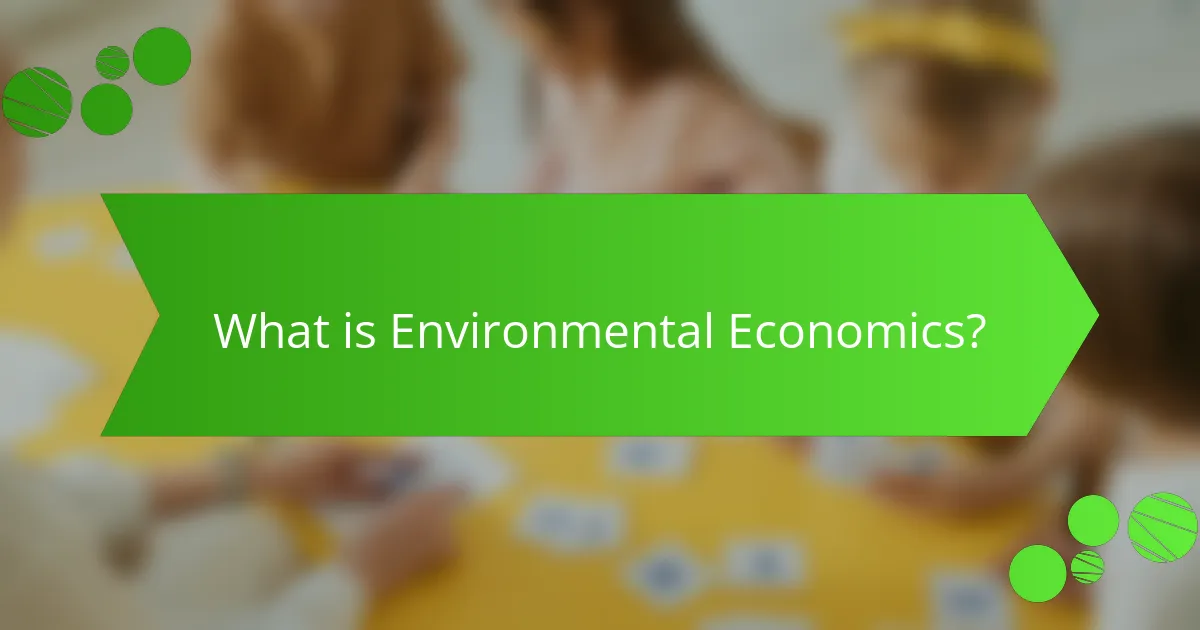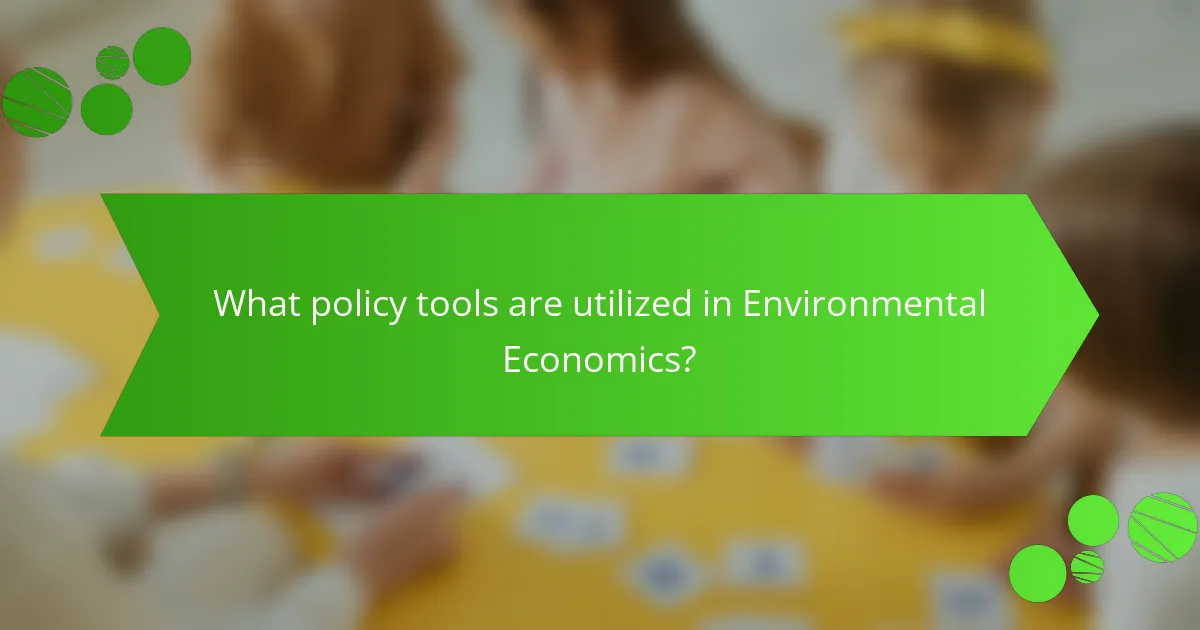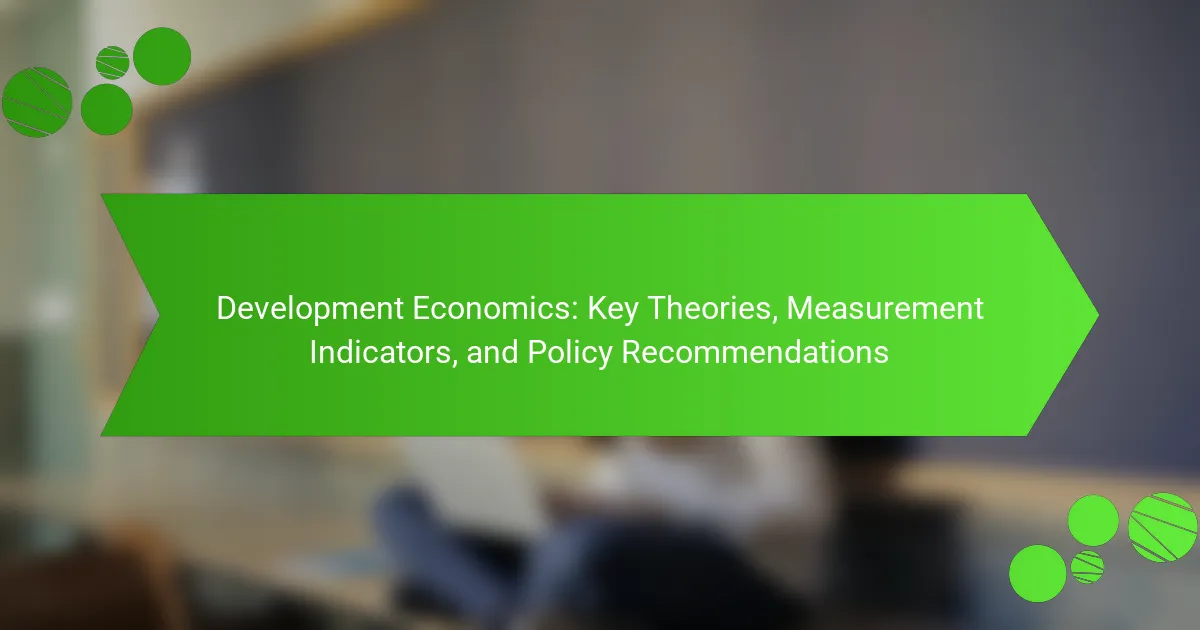Environmental economics is a specialized field that analyzes the economic implications of environmental policies and practices. It focuses on the interaction between economic activities and environmental outcomes, evaluating costs and benefits associated with environmental protection. The article delves into various policy tools utilized in environmental economics, including market-based instruments like carbon taxes, regulatory measures such as emission standards, and information-based strategies aimed at enhancing public awareness. Additionally, it highlights sustainable practices that promote resource conservation, pollution reduction, and efficient energy use, ultimately striving to balance economic growth with environmental sustainability.

What is Environmental Economics?
Environmental economics is a field of economics that studies the economic effects of environmental policies. It examines how economic activities impact the environment and how environmental policies can be designed to promote sustainable practices. This discipline integrates ecological and economic principles to evaluate the costs and benefits of environmental protection. Environmental economics also analyzes resource allocation, externalities, and market failures related to environmental issues. For instance, it assesses the economic implications of pollution, natural resource depletion, and climate change. By applying economic theories, environmental economists aim to find efficient solutions to environmental problems. The goal is to balance economic growth with environmental sustainability.
How does Environmental Economics relate to traditional economics?
Environmental economics is a subfield of traditional economics that focuses on the relationship between economic activities and environmental impacts. It incorporates environmental costs into economic decision-making processes. Traditional economics often overlooks these externalities, leading to market failures. Environmental economics seeks to correct this by evaluating the economic value of natural resources and ecosystem services. This field uses tools like cost-benefit analysis to assess environmental policies. It also emphasizes sustainable development, aligning economic growth with environmental protection. Studies show that integrating environmental considerations can enhance long-term economic stability. Thus, environmental economics enriches traditional economic theories by addressing ecological constraints.
What are the key differences between Environmental Economics and classical economics?
Environmental Economics focuses on the relationship between economic activity and the environment. Classical economics emphasizes market efficiency and the allocation of resources. Environmental economics incorporates ecological sustainability into economic analysis. Classical economics often neglects environmental costs and benefits.
In Environmental Economics, market failures related to externalities are addressed. Classical economics assumes that markets are efficient without government intervention. Environmental Economics promotes policies for sustainable resource management. Classical economics typically prioritizes short-term gains over long-term sustainability.
The valuation of natural resources is a key aspect of Environmental Economics. Classical economics often treats natural resources as infinite. Environmental Economics advocates for the integration of environmental considerations into economic decision-making. Classical economics primarily focuses on consumer preferences and utility maximization.
Why is Environmental Economics important in today’s world?
Environmental economics is important in today’s world because it addresses the relationship between economic activity and environmental health. It helps policymakers understand the costs and benefits of environmental protection. This field provides tools for evaluating the economic impacts of environmental regulations. For instance, the Global Commission on the Economy and Climate states that transitioning to a low-carbon economy could generate $26 trillion in economic benefits by 2030. Environmental economics also informs sustainable resource management. It emphasizes the need for efficient use of natural resources to prevent depletion. By integrating environmental costs into economic decision-making, it promotes long-term sustainability. This discipline supports the development of green technologies and renewable energy solutions. Overall, it plays a crucial role in shaping policies aimed at mitigating climate change and promoting ecological balance.
What are the fundamental principles of Environmental Economics?
The fundamental principles of Environmental Economics include the valuation of natural resources, the concept of externalities, and the notion of sustainable development. Valuation of natural resources assesses their economic worth, often through market mechanisms or contingent valuation methods. Externalities refer to the costs or benefits incurred by third parties not involved in a transaction, impacting social welfare. Sustainable development emphasizes meeting present needs without compromising future generations’ ability to meet theirs. These principles guide policy decisions and resource management. They help balance economic growth with environmental protection, ensuring long-term ecological health.
How do externalities affect environmental decision-making?
Externalities significantly influence environmental decision-making by altering the costs and benefits associated with environmental actions. They represent the unintended consequences of economic activities that affect third parties not directly involved in the transaction. For instance, pollution from a factory can harm local air quality, impacting public health and increasing healthcare costs for the community. This leads to a misalignment between private costs and social costs.
When decision-makers do not account for these externalities, they may prioritize short-term profits over long-term environmental sustainability. As a result, policies that aim to internalize these external costs, such as taxes on carbon emissions, can promote better environmental outcomes. Research shows that countries implementing such policies have seen reductions in emissions and improvements in public health. Therefore, recognizing and addressing externalities is crucial for making informed and sustainable environmental decisions.
What role do public goods play in Environmental Economics?
Public goods play a crucial role in Environmental Economics by providing benefits that are non-excludable and non-rivalrous. These characteristics mean that individuals cannot be effectively excluded from using them, and one person’s use does not diminish their availability to others. Examples include clean air, biodiversity, and public parks.
In Environmental Economics, the presence of public goods often leads to market failures. This occurs because private markets may underprovide these goods due to their inability to charge users directly. Consequently, government intervention is frequently necessary to ensure adequate provision and maintenance of public goods.
Research shows that investing in public goods can lead to significant improvements in social welfare. For instance, the World Bank highlights that ecosystem services, a form of public good, contribute substantially to economic development and poverty alleviation. Thus, public goods are essential for sustainable environmental practices and economic policies.
What are the main objectives of Environmental Economics?
The main objectives of Environmental Economics are to analyze the economic impact of environmental policies and to promote sustainable resource use. This field aims to understand the trade-offs between economic growth and environmental preservation. It evaluates the costs and benefits of environmental regulations. Environmental Economics also seeks to develop efficient market-based solutions for environmental issues. Additionally, it focuses on the valuation of natural resources and ecosystem services. By doing so, it informs policy decisions that balance economic development with ecological health. This approach helps in addressing climate change and biodiversity loss effectively.
How does Environmental Economics aim to achieve sustainable development?
Environmental Economics aims to achieve sustainable development by integrating economic principles with environmental stewardship. It evaluates the economic impacts of environmental policies and decisions. This field emphasizes the importance of resource allocation to promote efficient use of natural resources. Environmental Economics employs tools such as cost-benefit analysis to assess the trade-offs of environmental policies. Additionally, it advocates for market-based solutions, such as carbon pricing, to internalize environmental costs. By promoting sustainable practices, it seeks to balance economic growth with ecological health. Research indicates that policies informed by Environmental Economics can lead to more sustainable resource management. For instance, studies show that implementing green technologies can significantly reduce carbon emissions while fostering economic development.
What metrics are used to measure environmental economic performance?
Metrics used to measure environmental economic performance include Gross Domestic Product (GDP), ecological footprint, and environmental quality indices. GDP reflects economic activity but may overlook environmental degradation. The ecological footprint measures resource consumption and waste generation relative to Earth’s capacity. Environmental quality indices assess air, water, and soil conditions, providing insights into ecosystem health. These metrics help policymakers evaluate sustainability and economic impacts. For instance, the Human Development Index combines economic and environmental data to assess overall well-being.

What policy tools are utilized in Environmental Economics?
Policy tools utilized in Environmental Economics include market-based instruments, regulatory measures, and information-based strategies. Market-based instruments consist of taxes, subsidies, and tradable permits. For instance, carbon taxes incentivize reductions in greenhouse gas emissions. Regulatory measures involve direct regulations such as emission standards and environmental quality mandates. These regulations establish limits to protect natural resources. Information-based strategies provide public awareness campaigns and educational programs. These strategies aim to inform stakeholders about environmental impacts and sustainable practices. Collectively, these tools guide economic behavior toward environmental sustainability.
What are the different types of policy instruments in Environmental Economics?
The different types of policy instruments in Environmental Economics include command-and-control regulations, market-based instruments, and voluntary agreements. Command-and-control regulations mandate specific limits or standards for pollution emissions. Market-based instruments use economic incentives to encourage reductions in environmental harm. Examples include taxes, subsidies, and cap-and-trade systems. Voluntary agreements involve commitments by industries to achieve environmental goals without mandatory regulations. These instruments aim to address environmental issues effectively and efficiently.
How do market-based instruments function in promoting sustainability?
Market-based instruments function in promoting sustainability by creating economic incentives for environmentally friendly practices. These instruments include tools like carbon pricing, tradable permits, and subsidies for renewable energy. They encourage businesses and individuals to reduce their environmental impact by assigning a cost to pollution and resource depletion. For instance, carbon pricing makes emitting carbon dioxide more expensive, motivating companies to adopt cleaner technologies. Tradable permits allow companies with lower emissions to sell their excess allowances to higher emitters, promoting overall reductions in pollution. Research by the World Bank shows that carbon pricing has led to significant emissions reductions in countries that have implemented it. Additionally, subsidies for renewable energy sources like wind and solar power help lower their costs, making them more competitive with fossil fuels. Thus, market-based instruments effectively align economic activities with sustainability goals.
What are command-and-control regulations and how do they work?
Command-and-control regulations are legal frameworks used by governments to control environmental pollution. These regulations set specific limits on emissions and mandates for technology use. They require industries to comply with established standards to minimize environmental impacts. For example, the Clean Air Act in the United States imposes limits on air pollutants. Compliance is typically enforced through monitoring and penalties for violations. This regulatory approach aims to achieve environmental goals through direct oversight. Historical data shows that command-and-control regulations have led to significant reductions in pollutants. The effectiveness of these regulations is often measured through improvements in air and water quality.
How do economic incentives influence environmental policies?
Economic incentives significantly influence environmental policies by aligning financial motivations with ecological goals. These incentives can take various forms, such as subsidies, tax breaks, or market-based mechanisms like cap-and-trade systems. For example, subsidies for renewable energy sources encourage investment in clean technologies. Tax credits for energy-efficient appliances promote consumer adoption of sustainable products.
Market-based mechanisms create financial benefits for reducing emissions. The European Union’s Emissions Trading System incentivizes companies to lower their carbon output. Research shows that economic incentives can lead to measurable improvements in environmental outcomes. A study by the National Bureau of Economic Research found that states with strong renewable energy incentives saw a 20% increase in clean energy production.
In summary, economic incentives drive environmental policy effectiveness by making sustainable choices financially attractive.
What role do taxes and subsidies play in environmental protection?
Taxes and subsidies are critical tools in environmental protection. They influence behavior by making environmentally harmful activities more expensive or incentivizing sustainable practices. For instance, carbon taxes increase costs for fossil fuel use, encouraging a shift to renewable energy. Subsidies for clean technologies lower the financial barriers for adopting eco-friendly options. Research shows that countries implementing carbon pricing have reduced emissions significantly. According to the World Bank, over 40 national and 20 subnational jurisdictions have enacted carbon pricing mechanisms. These measures drive innovation and investment in green technologies, contributing to overall environmental sustainability.
How can tradable permits contribute to pollution reduction?
Tradable permits can contribute to pollution reduction by creating a market for emissions allowances. This system allows companies to buy and sell permits to emit a certain amount of pollutants. Companies that can reduce emissions at lower costs will sell their excess permits to those facing higher costs. This incentivizes innovation and efficiency in pollution control. The overall cap on emissions ensures that total pollution decreases. For example, the U.S. Acid Rain Program successfully used tradable permits to reduce sulfur dioxide emissions by over 50% since its implementation. This demonstrates the effectiveness of tradable permits in achieving environmental goals while allowing economic flexibility.
What challenges exist in implementing environmental policies?
Implementing environmental policies faces several challenges. These challenges include political resistance, which often stems from conflicting interests among stakeholders. Economic constraints can limit funding for environmental initiatives. Public awareness and understanding of environmental issues may be insufficient, reducing support for policies. Additionally, regulatory complexity can hinder effective implementation. There are also technological limitations that can restrict the adoption of sustainable practices. Furthermore, enforcement of policies can be weak due to lack of resources or political will. These factors collectively complicate the realization of effective environmental policies.
How do political factors impact the effectiveness of environmental policies?
Political factors significantly influence the effectiveness of environmental policies. The alignment of political will with environmental goals determines policy implementation success. For instance, strong government support can lead to effective regulations and funding for environmental initiatives. Conversely, political opposition may hinder policy enforcement and resource allocation.
Public opinion also plays a crucial role. Policymakers often respond to voter priorities, which can either promote or obstruct environmental agendas. Historical examples include the U.S. Clean Air Act, which gained traction due to public demand for cleaner air.
Additionally, international relations affect environmental policies. Countries may collaborate on global issues like climate change, but political tensions can impede progress. For example, the Paris Agreement saw varying levels of commitment based on national interests.
In summary, political factors shape the landscape of environmental policies through government support, public opinion, and international dynamics.
What are the economic barriers to adopting sustainable practices?
Economic barriers to adopting sustainable practices include high initial costs, limited access to financing, and uncertain returns on investment. High initial costs deter businesses from investing in sustainable technologies. Many sustainable options require significant upfront capital, which can be a barrier for small and medium enterprises. Limited access to financing further exacerbates this issue, as not all businesses can secure loans for sustainable projects. Uncertain returns on investment create hesitation among investors. The long-term benefits of sustainability may not be immediately apparent, making it difficult to justify the initial expenditure. Additionally, market structures often favor traditional practices over sustainable alternatives, hindering adoption.

What sustainable practices are promoted by Environmental Economics?
Environmental Economics promotes sustainable practices such as resource conservation, pollution reduction, and efficient energy use. These practices aim to balance economic growth with environmental protection. For example, implementing carbon pricing encourages businesses to reduce greenhouse gas emissions. Additionally, promoting renewable energy sources like solar and wind helps decrease reliance on fossil fuels. Sustainable land use practices, such as agroforestry, enhance biodiversity while providing economic benefits. Furthermore, environmental impact assessments ensure that development projects consider ecological consequences. By integrating these practices, Environmental Economics fosters a sustainable future while supporting economic development.
How can businesses adopt sustainable practices through Environmental Economics?
Businesses can adopt sustainable practices through Environmental Economics by integrating economic principles that account for environmental costs. This approach encourages the valuation of natural resources and ecosystems in decision-making. For instance, businesses can implement cost-benefit analysis that includes environmental impacts. This method helps identify the financial advantages of sustainable practices. Additionally, adopting policies like carbon pricing incentivizes reductions in greenhouse gas emissions. Research shows that companies investing in sustainability can improve their long-term profitability. A study by the Harvard Business School found that firms with strong sustainability practices outperform their peers financially. Thus, using Environmental Economics enables businesses to align economic goals with environmental stewardship.
What are examples of corporate sustainability initiatives?
Examples of corporate sustainability initiatives include renewable energy adoption, waste reduction programs, and sustainable sourcing practices. Companies like Google have committed to using 100% renewable energy for their operations. Unilever has implemented a waste reduction strategy that aims to halve its waste footprint by 2025. Patagonia focuses on sustainable sourcing by using recycled materials in its products. IKEA has pledged to become climate positive by 2030 through energy efficiency and sustainable materials. These initiatives demonstrate a commitment to reducing environmental impact and promoting sustainability in business practices.
How does supply chain management relate to sustainability?
Supply chain management relates to sustainability by optimizing resource use and minimizing environmental impact. It involves the management of goods from production to delivery. Sustainable supply chain practices reduce waste and emissions. For example, companies can implement eco-friendly sourcing and logistics. This reduces carbon footprints and conserves resources. Research shows that sustainable supply chains can enhance profitability. According to a study by the World Economic Forum, sustainable practices can lead to a 20% reduction in costs. Therefore, effective supply chain management is crucial for achieving sustainability goals.
What role do consumers play in promoting sustainability?
Consumers play a crucial role in promoting sustainability through their purchasing decisions. Their choices can drive demand for sustainable products and services. When consumers prioritize eco-friendly options, businesses are incentivized to adopt sustainable practices. This shift can lead to reduced environmental impact and resource conservation. For instance, a study by Nielsen in 2015 showed that 66% of global consumers are willing to pay more for sustainable brands. Additionally, consumer advocacy can influence policy changes that support sustainability initiatives. Thus, consumer behavior significantly shapes market trends towards sustainability.
How can consumer behavior influence environmental outcomes?
Consumer behavior significantly influences environmental outcomes through purchasing decisions and lifestyle choices. When consumers opt for sustainable products, they drive demand for eco-friendly alternatives. This shift can lead to reduced carbon footprints and lower resource consumption. For instance, studies show that increased demand for organic products has led to a 20% growth in organic farming, which uses fewer pesticides and promotes biodiversity. Additionally, consumers who prioritize energy efficiency can encourage companies to innovate and produce greener technologies. Research indicates that if 10% of households switch to energy-efficient appliances, it could reduce greenhouse gas emissions equivalent to taking 1.5 million cars off the road. Therefore, consumer choices directly impact environmental sustainability by shaping market trends and influencing corporate practices.
What are the benefits of sustainable consumption?
Sustainable consumption provides numerous benefits that contribute to environmental preservation and social well-being. It reduces resource depletion by promoting efficient use of materials. This efficiency helps lower greenhouse gas emissions, mitigating climate change impacts. Sustainable consumption also encourages ethical production practices, enhancing labor conditions and community welfare. Additionally, it fosters economic resilience by supporting local businesses and sustainable industries. Evidence shows that sustainable consumption can lead to significant reductions in waste generation, as seen in countries with strong recycling programs. Overall, the benefits of sustainable consumption are interconnected, promoting a healthier planet and society.
What best practices can individuals adopt for sustainability?
Individuals can adopt several best practices for sustainability. Reducing energy consumption is essential. Simple actions like turning off lights and using energy-efficient appliances can significantly lower energy use.
Minimizing waste is also crucial. Individuals should recycle materials like paper, glass, and plastics. Composting organic waste reduces landfill contributions and enriches soil.
Choosing sustainable transportation options is another effective practice. Walking, biking, or using public transport can reduce carbon emissions.
Supporting local and organic products helps promote sustainable farming. This practice reduces transportation emissions and supports local economies.
Conserving water is important as well. Simple measures, such as fixing leaks and using water-efficient fixtures, can lead to significant savings.
Educating oneself and others about sustainability can foster a culture of environmental awareness. Sharing knowledge encourages more people to adopt sustainable practices.
These practices collectively contribute to a more sustainable lifestyle. They help mitigate climate change and promote the health of our planet.
How can individuals reduce their carbon footprint effectively?
Individuals can reduce their carbon footprint effectively by adopting sustainable practices in daily life. Using public transportation or cycling instead of driving can significantly lower greenhouse gas emissions. Reducing meat and dairy consumption decreases the carbon footprint associated with livestock farming. Implementing energy-efficient appliances in homes can lead to lower energy consumption. Using renewable energy sources, such as solar panels, can further minimize reliance on fossil fuels. Reducing water usage also contributes to lower carbon emissions, as water treatment requires energy. Recycling and composting can help divert waste from landfills, reducing methane emissions. Each of these actions contributes to a collective effort in combating climate change.
What are practical tips for adopting sustainable living habits?
Adopting sustainable living habits involves making conscious choices that reduce environmental impact. Start by reducing single-use plastics. Use reusable bags, bottles, and containers to minimize waste. Next, conserve energy by switching to energy-efficient appliances. According to the U.S. Department of Energy, these appliances can save up to 30% on energy bills. Additionally, consider using public transportation or biking instead of driving. This reduces carbon emissions significantly.
Another tip is to support local and organic food sources. Purchasing locally reduces transportation emissions and supports local economies. Composting kitchen waste is also beneficial. It reduces landfill waste and enriches soil. Finally, educate yourself and others about sustainability practices. Knowledge sharing can amplify positive environmental impacts.
Environmental economics is a specialized field of economics that examines the interplay between economic activities and environmental policies, focusing on sustainable practices. The article outlines the principles of environmental economics, including the valuation of natural resources, externalities, and sustainable development, while highlighting the importance of integrating environmental costs into economic decision-making. It discusses various policy tools such as market-based instruments, command-and-control regulations, and the role of public goods in addressing environmental issues. Additionally, the article explores challenges in implementing these policies and the significance of consumer behavior in promoting sustainability, ultimately emphasizing the need for a balanced approach to economic growth and environmental protection.



